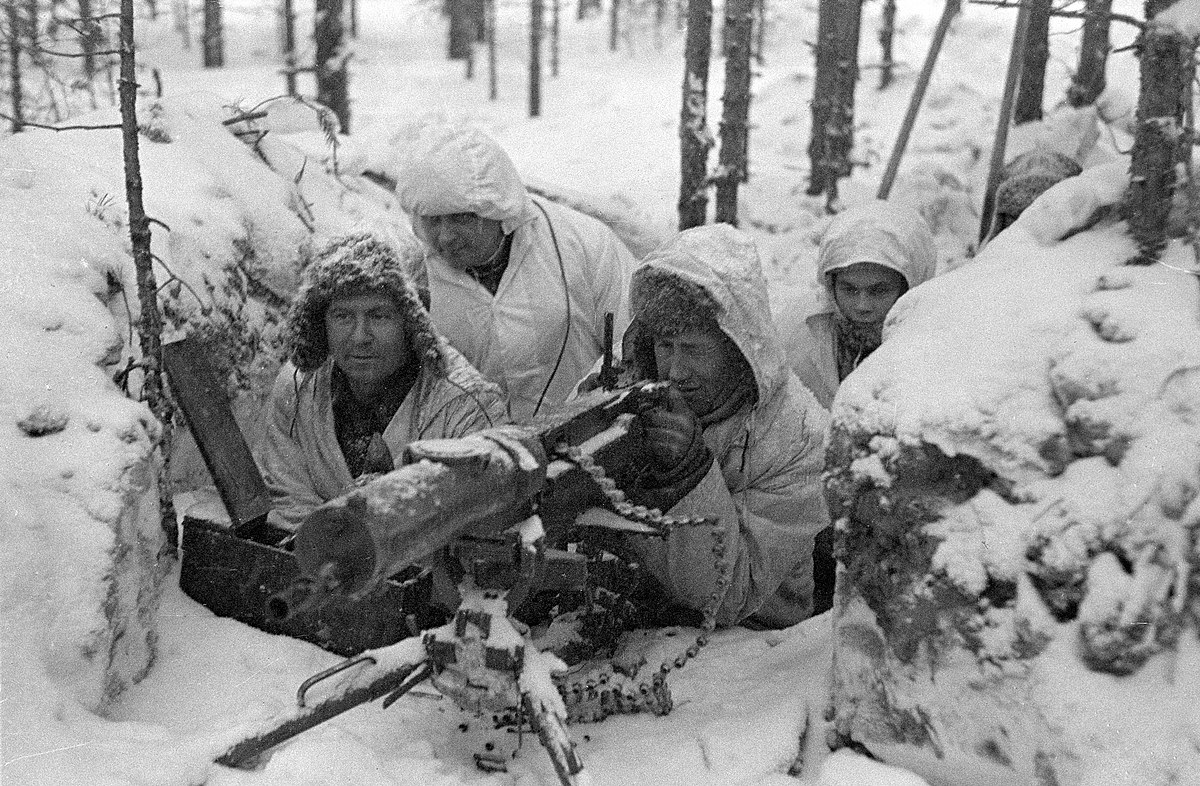 Finnish Machine Gun Nest During the Winter War | Photo Credit: Military Museum of Finland
Finnish Machine Gun Nest During the Winter War | Photo Credit: Military Museum of Finland
The Spring War: How Finland’s Winter War Compares to Ukraine
The Russian military on paper outnumbers and outguns Ukraine in terms of land, sea, and air capabilities. Bolstered by a large spending spree in its offensive capabilities, the Russian military is a far cry from the 1990s when soldiers regularly went without pay. American intelligence, in predicting Russia’s invasion of Ukraine, believed that Kyiv would fall in 48 hours, resulting in the successful overthrow of Volodymyr Zelensky’s government. Four weeks after the invasion, the Russian military has proven inept in capturing its major targets or overrunning the country. Such Russian military failures have prompted several questions on the country’s status as a great power, though such skepticism should be exercised cautiously as the war isn’t over yet. This war, however, does bear a good resemblance to the Soviet Union’s 1939-40 Winter War with Finland, providing a possible resolution to the war that can leave Ukraine as a smaller, but sovereign, nation.
Though there are significant differences between the Winter war and the war in Ukraine, the similarities are striking. While the motivations for both wars are different, Stalin’s desire for a territorial buffer north of Leningrad is comparable to Putin’s desire for a sphere of influence over Ukraine that keeps NATO distant. The Soviet Union’s performance in the Winter War was abysmal, losing over 200,000 troops in a matter of three months, while inflicting only 25,000 casualties on Finland. In response to the motivated, highly mobile, easily concealed, and lethal Finnish forces, the Soviets changed tactics, eventually breaking through Finnish defenses with massive bombardment campaigns combined with tanks supporting infantry movements. This led to a peace agreement that forced Finland to cede eleven percent of its territory, though its success in bleeding the Red Army white led Finland to remain a sovereign nation.
Putin has made largely the same mistakes as his Soviet predecessor. He was wildly optimistic in his belief of a quick victory leading to poor logistical preparation that set up Russian soldiers for rapid battlefield failures and severe morale issues. According to reports from captured soldiers, they were given supplies for two to three days and told they would be greeted as heroes instead of conquerors. The Russian air force, which vastly outnumbers Ukraine’s, has seen limited usage, leading some to speculate whether Russia is running low on precision-guided missiles, or simply unable to eliminate Ukraine’s air defenses. On the other side, Ukrainian troops remain highly motivated to defend their country and have received weaponry that evens the odds on the battlefield. Accurate casualty numbers are difficult to find, but Russian news recently reported Russian casualties at nearly 10,000. This conflict, thankfully, isn’t as bloody as the Winter War yet, though the events leading up to the invasion, issues throughout the war, and the recent change in tactics bear a resemblance to that war.
Ukraine does have significant advantages compared to 1939 Finland in confronting Russia. European opinion is more united in confronting Russia now than in 1939. In terms of population, the Soviet Union was 35 times larger than Finland in 1940, while Russia today is only a little more than three times as populous as Ukraine. Today, Ukraine is also receiving major arms shipments that significantly level the playing field. But like Finland, it can only do so well in the face of an enemy against which it is still ostensibly outnumbered and outgunned. Russia has made advances in the south of Ukraine, taking Kherson, and though Kyiv was at risk of being encircled by Russian forces, the Ukrainian military appears to be in the process of attempting its own encirclement of Russian forces outside of Kyiv. Russia is also using bombardment in an attempt to break public morale, as can be seen in Mariupol. As the war continues, CSIS fellow Benjamin Jensen recently stated that half of interstate wars since the end of WWII last more than a year with such conflicts lasting over a decade on average. A protracted war would damage Ukraine’s long-term prospects and leave it in a less favorable position in the bargaining table.
Currently, the recent peace talks between Russia and Ukraine have yet to achieve a breakthrough. Ukraine is already willing to forgo NATO membership, though such a concession wouldn’t be enough for Putin to withdraw his troops. As such, Ukraine must continue to fight, hold, and retake as much territory as possible so it can obtain a favorable deal at the negotiating table. However, it may have to concede Russian control of Crimea or even allow Donetsk and Luhansk to remain autonomous, but unrecognized. Looking back, even though Finland lost a portion of its territory to the Soviets, the country remains free and is an active member of the European Union today. A deal conceding Crimea and forgoing NATO membership will not be the outcome many of those sympathetic to Ukraine desire, though these major concessions could provide the basis to demand security guarantees from Russia that would allow Ukraine to remain sovereign just as Finland still is today.





